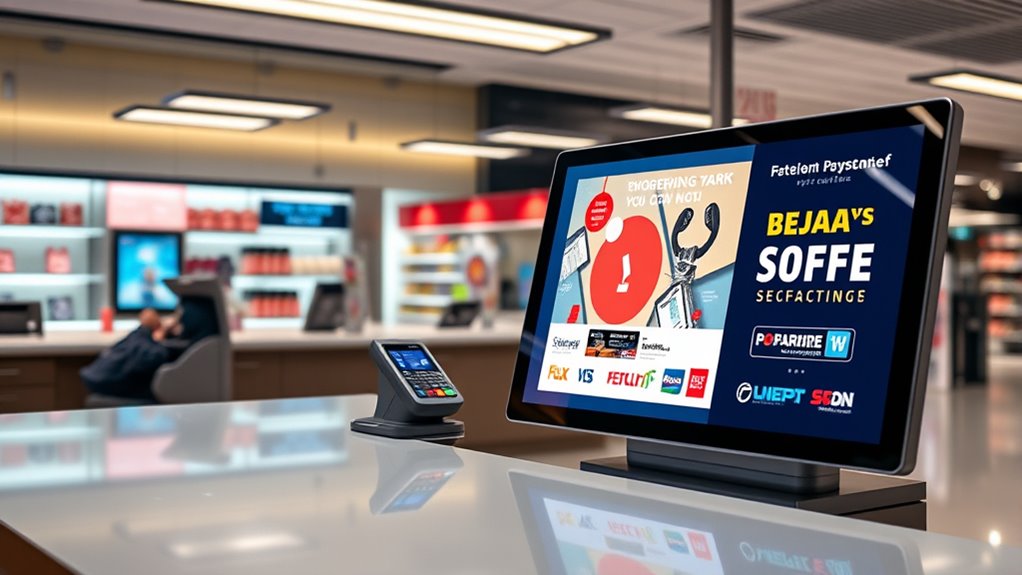Advertising now meets automation at the point of sale by using AI and smart technology to create personalized, seamless experiences. You can deliver targeted messages, optimize customer journeys, and gather valuable data to boost engagement and sales. Automation helps streamline transactions while providing real-time insights for better marketing strategies. If you want to discover how these innovations are transforming retail advertising, keep exploring this exciting intersection.
Key Takeaways
- Automated POS systems enable real-time, personalized advertising messages tailored to individual customer preferences.
- AI-driven analytics at the point of sale optimize promotional strategies and enhance customer engagement.
- Integration of omnichannel marketing ensures consistent brand messaging across POS, social media, and digital channels.
- Digital POS technology provides valuable data insights to refine targeted advertising campaigns.
- Automation at the point of sale streamlines transactions, improves customer experience, and increases conversion rates.

As digital technology continues to transform the retail landscape, advertising at the point of sale is increasingly driven by automation and artificial intelligence. This shift allows you to deliver personalized, timely messages that resonate with your customers right where they make purchasing decisions. The market for marketing automation is booming, expected to reach $15.62 billion by 2030 with a steady growth rate of 15.3% annually. AI is the backbone of this expansion, powering 77% of content creation in marketing automation, which means your campaigns are becoming smarter and more efficient. You can now automate complex customer journeys, with nearly 40% of marketers having mostly or fully automated these processes, leading to more consistent and personalized experiences across touchpoints.
Automation and AI are revolutionizing retail advertising, enabling personalized, seamless customer experiences at the point of sale.
In the domain of sales, automation is making a significant impact. Digital channels will account for 80% of all B2B sales engagements by 2025, underscoring how automation fuels your sales strategies. AI is expected to redefine sales roles, with 74% of sales professionals believing it will significantly alter their responsibilities. Implementing AI-powered CRM solutions can streamline your day-to-day tasks, saving approximately five hours each week, so you can focus more on strategic activities. Additionally, automation reduces human errors by around 20%, enhancing accuracy and reliability during transactions and customer interactions.
Omnichannel marketing is becoming essential as customers demand seamless experiences across different platforms. Automation tools now integrate various channels—email, text, social media—creating consistent messaging and a unified customer journey. By understanding customer preferences and interactions through advanced analytics, you can tailor messages to meet individual needs, reinforcing brand loyalty. Techniques like A/B testing and data-driven optimization help refine your campaigns, ensuring that your efforts across all channels work harmoniously to boost engagement and conversions.
Artificial intelligence’s adoption in marketing has skyrocketed from 29% in 2021 to an anticipated 88% in 2025, with over 95% expected by 2030. AI’s practical applications—such as faster responses to customer queries and workflow integration—save you time and improve operational efficiency. Nearly three-quarters of marketers are already using AI tools, a figure more than double from just a year prior, signaling rapid growth. As AI continues to evolve, expect even more sophisticated solutions that plug gaps in your workflows and give you a competitive edge.
The point of sale technology landscape reflects this digital transformation. The global POS terminal market hit $113.38 billion in 2024 and is projected to reach $181.47 billion, reflecting widespread adoption of digital transaction methods. This growth emphasizes how automation at the point of sale can enhance your customer’s experience, reduce transaction times, and provide valuable data insights. By integrating these advanced technologies into your retail operations, you position yourself at the forefront of advertising innovation, making every customer interaction more personalized, efficient, and impactful. Furthermore, understanding the greater happiness principle can guide your marketing strategies to align with customer values and ethics, fostering deeper connections.
Frequently Asked Questions
How Does Automation Impact Customer Privacy at the Point of Sale?
Automation impacts your privacy at the point of sale by collecting vast amounts of personal data through sensors, cameras, and AI. While it streamlines transactions and enforces privacy laws, it also creates risks of data breaches and misuse. You might feel hesitant if your sensitive information isn’t handled transparently. Automation can support privacy compliance, but it’s essential that retailers balance efficiency with clear communication and give you control over your data.
What Are the Initial Costs for Implementing Automated Advertising Systems?
Your initial costs for implementing automated advertising systems can range from around $1,200 to $4,000 or more. This includes hardware like terminals and card machines, plus software setup fees, which vary from free to a few thousand dollars. You’ll also face onboarding, integration, and staff training expenses. Keep in mind, these costs can increase if you opt for custom solutions or advanced marketing automation features.
How Can Small Businesses Effectively Utilize POS Automation?
You can effectively utilize POS automation by choosing affordable, cloud-based systems that match your business size. Use automation features like real-time sales tracking, inventory management, and customer data collection to streamline operations and personalize marketing. Automate employee scheduling and receipts to save time. Integrate loyalty programs and targeted promotions to boost customer engagement. Regularly review reports to optimize strategies and stay ahead, ensuring your POS system grows with your business.
What Are the Common Challenges Faced During Automation Integration?
Imagine maneuvering a winding river with hidden rocks beneath the surface—that’s what integration challenges often feel like. You’ll encounter compatibility issues with diverse systems, security hurdles, and the need for ongoing updates. Data silos and manual adjustments can slow progress, while the initial investment and training demands might seem daunting. Staying patient, planning carefully, and choosing flexible solutions help you steer through these obstacles toward smoother automation.
How Is Data Security Maintained in Automated POS Advertising?
You maintain data security in automated POS advertising by implementing end-to-end encryption, ensuring all transaction data stays protected during transmission. You use tokenization to replace sensitive info with random tokens, reducing breach risks. Multi-factor authentication, role-based access, and biometric verification control who can access sensitive systems. Regular audits, updated security patches, firewalls, and intrusion detection keep your network safe. Monitoring and incident response plans help you quickly address any security threats or breaches.
Conclusion
As you embrace automation at the point of sale, remember that “the whole is greater than the sum of its parts.” Combining targeted advertising with seamless technology enhances customer experience and boosts sales. By staying ahead of the curve, you turn every transaction into an opportunity, proving that innovation isn’t just about technology but about understanding your customers’ needs. Keep evolving, and you’ll find success where traditional methods fall short.









